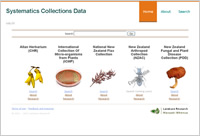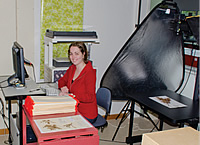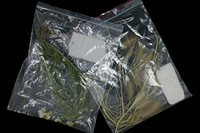Issue 3, February 2013
Latest research news
New grass images online: 500 new images have been added to the electronic Flora of New Zealand. Of these, 188 are of the genera Chionochloa and Rytidosperma, and the remaining photographs are spread among the rest of the 464 species of grasses in 120 genera, with a slight bias towards lowland naturalised species. This is a result of a TFBIS project that also funded new characters and images for the Danthoniinae subtribe in the NZGrass interactive key.
Cryptogam type database and imaging:  TFBIS funded the creation of 688 electronic records of cryptogam type specimens from the Allan Herbarium. A total of 422 specimens were photographed (180 mosses, 88 liverworts, 101 lichens, and 53 specimens from the separate Beckett collection). The new information is available on the Landcare Research New Zealand Plants website (http://nzflora.landcareresearch.co.nz), and the Systematics Collections Data website (http://scd.landcareresearch.co.nz; screenshot on right).
TFBIS funded the creation of 688 electronic records of cryptogam type specimens from the Allan Herbarium. A total of 422 specimens were photographed (180 mosses, 88 liverworts, 101 lichens, and 53 specimens from the separate Beckett collection). The new information is available on the Landcare Research New Zealand Plants website (http://nzflora.landcareresearch.co.nz), and the Systematics Collections Data website (http://scd.landcareresearch.co.nz; screenshot on right).
Just published: generic relationships of Brassicaceae in Australia and New Zealand that were unassigned to a tribe have been investigated by Peter Heenan and colleagues from Landcare Research and Masaryk University, Czech Republic. Results included an expanded tribe Microlepidieae, now with 16 genera and 56 species endemic to Australia and New Zealand. Pachycladon is shown to be a member of the Microlepideae. Taxon 61: 970–979.
Also just published: in a study utilising DNA fingerprinting, Constantijn Mennes, Rob Smissen (Allan Herbarium) and Pieter Pelser (University of Canterbury) found no support for separating Brachyglottis saxifragoides and B. lagopus from Banks Peninsula, Canterbury. Constantijn’s work on this project was undertaken during his internship at the Allan Herbarium from Leiden University in the Netherlands. New Zealand Journal of Botany 50: 489–495.
New project: the Global Plant Initiative (GPI):  Since late 2012, the Allan Herbarium has been one of >166 herbaria contributing to the online digitisation of plant type specimens worldwide. Our aim is to digitise 2000 herbarium sheets containing type specimens of vascular plants; 200 have been completed to date. The information is delivered via JSTOR Plant Science, with equipment (right) and assistance from the Royal Botanic Gardens (Kew), and funding from the Andrew W. Mellon Foundation.
Since late 2012, the Allan Herbarium has been one of >166 herbaria contributing to the online digitisation of plant type specimens worldwide. Our aim is to digitise 2000 herbarium sheets containing type specimens of vascular plants; 200 have been completed to date. The information is delivered via JSTOR Plant Science, with equipment (right) and assistance from the Royal Botanic Gardens (Kew), and funding from the Andrew W. Mellon Foundation.
Requirements for plant identifications at the Allan Herbarium
Specimens sent to the Plant Identification Service should include as many features as possible, especially reproductive parts. For small herbaceous species, send the whole plant. For larger, bulky herbaceous plants, select material from the flowers, stems, leaves, and if possible, roots. For woody plants, please include a basal shoot with juvenile leaves, bark where applicable, and material of any other special feature present, e.g. spines or prickles, flowering and fruiting shoots.
The more complete the specimen, the easier and more accurate the identification is likely to be. It may not be possible to identify non-flowering or non-fruiting plants with certainty.
It is also important to give any details of the plant that may not be obvious at the receiving end; for example, size and shape (particularly of trees). Flowers and fruit often deteriorate, sometimes changing colour, so note any colours and fragrance. If the specimen is known to be atypical, this should also be noted (typical material should be sent for comparison).
Additional information we would like to know about your plant:
- The locality of collection: if the specimen represents a very rare species, or is a new record for the area from which it is sent, detailed information is important for the Herbarium's records.
- Habitat (e.g. open river bank, forest edge, under forest canopy, denuded pasture, desert, sun, shade): the appearance and distinguishing characters of a species can vary dramatically depending on environmental factors.
- Biostatus (e.g. cultivated material, wild).
- Name of the collector and date of collection.
Sending the specimens:
 Send specimens in a plastic bag or between moist sheets of newspaper inside a plastic bag. If the transit period is likely to be more than two days, put the plant between sheets of slightly moist newspaper and surround this with cardboard. To prevent the specimen wilting, a handful of water (and no more) should be splashed inside the bag.
Send specimens in a plastic bag or between moist sheets of newspaper inside a plastic bag. If the transit period is likely to be more than two days, put the plant between sheets of slightly moist newspaper and surround this with cardboard. To prevent the specimen wilting, a handful of water (and no more) should be splashed inside the bag.
If two or more similar plants are being sent, they should be put in separate bags to avoid confusion. Number multiple specimens to facilitate the reply. A copy of each specimen should be retained by the sender because we do not return specimens unless specifically requested.
Aquatic plants rot in jars or plastic bags, especially if muddy root systems are enclosed. They are best washed and put between damp cloth or paper. Succulent plants can be packed in dry newspaper and will often stay fresh for weeks.
Where the time between collection and dispatch is likely to be considerable, e.g. weeks, dry the plants before sending. Specimens are best pressed and dried between sheets of newspaper or blotting paper under a warm, dry atmosphere. Examine them occasionally, and if necessary change the papers to prevent mould. Keep the specimen flat under pressure or weights. Wilted or shrivelled material should not be pressed unless absolutely unavoidable.
Address the package to:
Plant Identification and Information Service
Landcare Research
PO Box 40
LINCOLN 7640
~Ines Schönberger, Herbarium Manager
